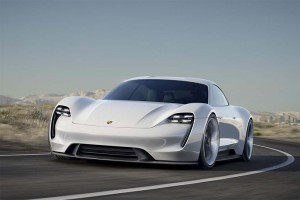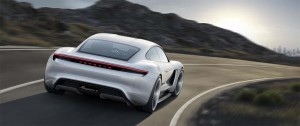If you’re image of a battery car runs along the lines of a Nissan Leaf, Toyota Prius or Chevrolet Volt, something, slow, awkward and anything but fun to drive, Porsche is about to blow your doors off.
The German maker is on a mission to redefine the battery car. Mission E, that is. Looking like it’s rolled out of a sci-fi flick, the concept car Porsche is unveiling at the Frankfurt Motor Show is meant to prove that Tesla isn’t the only automaker that can be both mean and green.
The 600-horsepower Porsche Mission E will launch from 0 to 100 kmh, or 62.5 mph, in under 3.5 seconds, yet get more than 310 miles per charge if you’re a little more gentle on the throttle. And if you do want to see what it can deliver on the track, Porsche says you can get an 80% battery charge-up in just 15 minutes.
“This is more than a show car, it’s a concept car that we can realize,” said Wolfgang Hatz, Porsche’s R&D chief, during a Monday night preview ahead of the Frankfurt Motor Show. “To put it into production we’ll need three to three-and-a-half years.”
(Click Here for TheDetroitBureau.com’s complete Frankfurt Motor Show coverage.)
Before you dismiss the idea of a Porsche battery car, think back over the years. In fact, founder Ferdinand Porsche’s first car, the Loehner-Porsche Mixt, of a century ago, was a very primitive plug-in hybrid. It even had wheel-mounted motors, a concept just being tinkered with again today.
Much more recently, Porsche demonstrated the potential of electric propulsion with the 918 Spider, a plug-in hybrid supercar.
“With this car we intend to start a new era with Porsche, similar to the 911 fifty years ago,” said Hatz.
The good news about electric power is that it actually generates peak torque the moment the motors start turning. In the case of the Porsche Mission E, there are two motors, one on each axle producing a combined 600-hp. The layout creates a concept often referred to as “through-the-road-all-wheel-drive,” which helps enhance traction.
The Porsche Mission E borrows a page from the 911 Turbo (and new Carrera S) tech spec page, adding all-wheel-steering, as well, to further enhance handling at high speeds, and maneuverability when crawling around on city streets or in a parking lot.
The Porsche Mission E is almost exactly the length of a 911, but about an inch wider. It features a more sci-fi like shape, a blend of the 911 and 918 Spider.
Not surprisingly, Porsche says the concept uses a mix of aluminum, high-strength steel and strong, yet super-light, carbon fiber. It rides on 21-inch wheels up front, 22s in the rear.
The German maker isn’t saying much about the battery pack but lithium-ion is the current state of the art. To deliver that sort of range, something north of 80 to 90 kilowatt-hours would likely need be packed inside the Mission E body. Porsche makes note of the concept’s low center of gravity which suggests it is packing those batteries as low as possible, perhaps in the load floor itself, the approach taken by Tesla.
The California EV maker has become a target for, well, just about everyone in the industry, from mainstream manufacturer to luxury brands now including Mercedes-Benz, BMW, Audi, and now Porsche.
During the same Frankfurt preview, fellow Volkswagen AG brand Audi revealed a three-motor battery SUV, the e-tron Quattro concept, which also promises 310 miles in range and solid performance. Audi officials say they plan to have it in production by 2018.
(Click Here for more on the Audi e-tron Quattro concept.)
Both the Porsche and the Audi battery cars clearly share some of the same components, and the two brands are working up similar solutions to problems like aerodynamics. The Mission E and e-tron Quattro both replace conventional sideview mirrors with cameras, for example.
The Porsche battery car also employs a camera following the driver’s eyes. That allows it to know what gauge you’re looking at and then highlight it.
Porsche officials say that they’re also serious about producing the Mission E – and if that happens, it would likely go for something in the low- to mid-$100,000 range, a fraction of the price tag of the Porsche 918 Spider.
(Mercedes among the brands taking aim at Tesla. Click Here to see what it’s planning.)



It should be obvious from Porsche, Audi, BMW etc. coming EVs that they are desperate to get some consumers to buy these vehicles so that the fines for not making the absurd 54.5 mpg CAFE decree by Obama and the EPA are as low as possible or all new car sales will tumble.
Actually, I think this is also due to the success of Tesla – a car consistently rated high in almost every way.
As battery technology improves, electrics are going to be the norm, not the exception.
Considering EV sales and prices are dropping I doubt Porsche’s EVs have anything to do with EVs ever becoming the norm because they won’t. Hydrogen fuel cells will replace battery powered EVs for those who desire a “zero emissions” vehicle.
Porsche like Audi has used motorsport to demonstrate their engineering skills with hybrids. The Porsche 918 is a cool tech car but just a halo product to showcase Porsche’s engineering capabilities. Porsche has a real issue meeting the absurd 54.5 mpg CAFE requirement because their entire product line is performance oriented and thus average mpg is lower than an auto company that sells a variety of commuter based cars such as VW. Being bought by VW may have actually saved Porsche owners from outrageous mpg fines? Selling EVs and hybrids are Porsches only means to lower the mpg fines on their entire product line.
All of the auto makers are forced to sell hybrids, EVs and bicycles to try and reduce the fines because no major car maker can currently meet the 54.5 mpg CAFE decree that is not based on science, but instead it’s based of ignorance.
Consumers are paying for all of this folly with sticker prices jumping disproportionately year after year to pay for this ignorance. No one is immune from this abuse except auto makers who do not sell products in the U.S. All of these EVs will be toxic waste that society must deal with in a few years when hydrogen fuel cells take control of the zero emissions market.
Petrol and Diesel powered vehicles will remain the dominant form of personal transportation for at least the next 100 years, probably a lot longer.